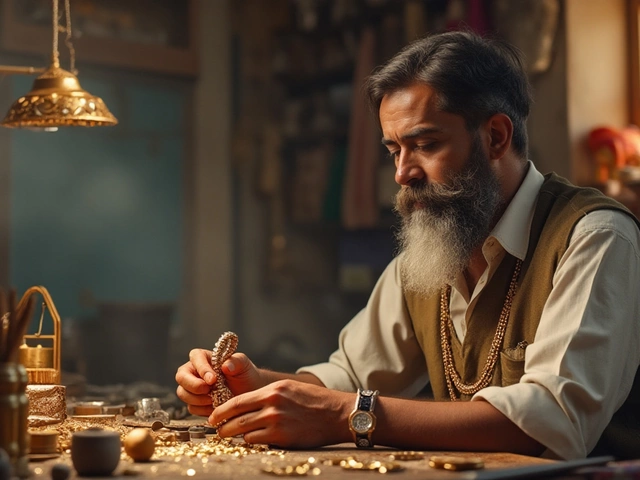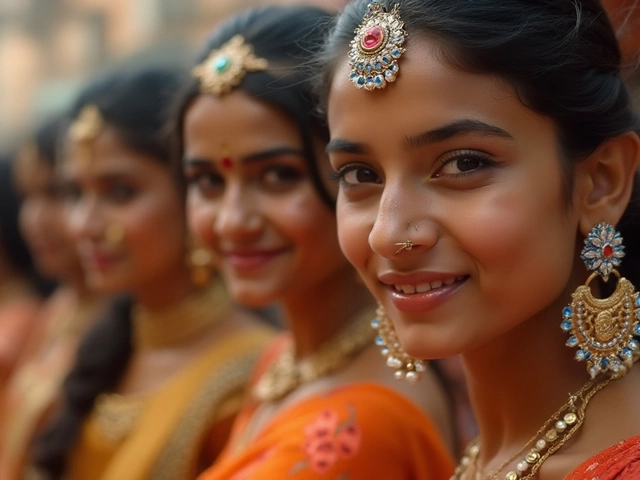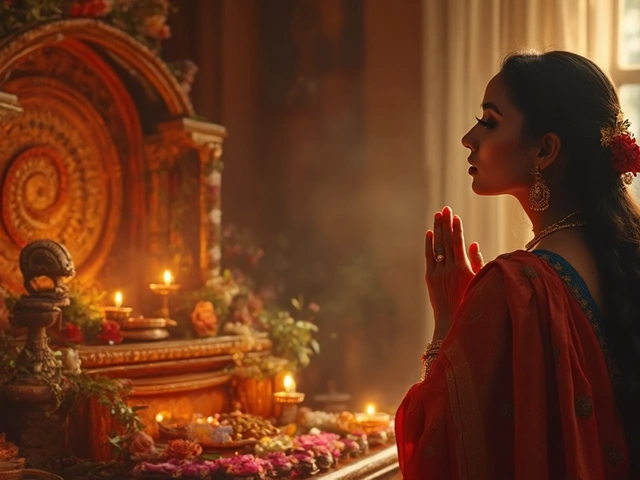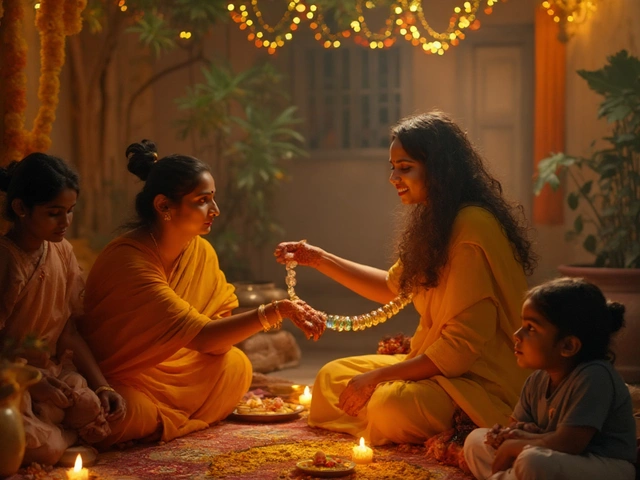You see those tiny black beads dotted along a mangalsutra and maybe you just think, yeah, they look pretty classic. But hang on—there’s a reason they’ve stuck around for centuries, and it’s not just about style. Black beads haven’t just landed on mangalsutras by accident. They carry a story, a bunch of old-school beliefs, and some life-saving tips for couples that you probably won’t find stitched into any plain gold chain.
So, what are these black beads really doing there? The short version: they’re said to keep bad vibes out and good luck in—yeah, seriously. Ask any grandmother in India, and she’ll tell you all about how these beads protect newlyweds from the so-called “evil eye.” It’s all about shielding the marriage from jealous glances and random negativity people throw your way. Even if you’re not the superstitious kind, it’s hard to ignore how much importance people give to this one tiny design choice. Plus, they’ve become a halo of tradition, passed down from one generation to the next, sometimes even as family heirlooms.
- The Origins of the Mangalsutra
- The Science and Superstition of Black Beads
- Symbolism in Modern Designs
- Myths People Still Swear By
- How to Choose Your Mangalsutra
- Beginners’ Care and Style Tips
The Origins of the Mangalsutra
The mangalsutra didn’t just pop up in Indian weddings one day. This tradition goes way back—like, centuries back. Old Sanskrit texts mention a sacred thread called “mangalya sutra,” which literally means ‘auspicious thread’. It was traditionally tied around a bride’s neck to show she was married, sort of like a wedding ring in Western countries. This thread wasn’t just any necklace; it was believed to create a direct link between husband and wife, acting as a bond that held the marriage together. You’ll still hear this belief echoed at wedding rituals all over India.
Now, different regions of India have their own spins on the mangalsutra. For example, in Maharashtra, you’ll find two gold vatis flanking the strings of black beads, while in South India, the thali or thirumangalyam design replaces the vatis. In North India, the designs get changed up with fancy gold pendants and more decorative beads. But no matter where you look, the basic idea—a black beaded chain given at the wedding ceremony—remains the same. That’s why the mangalsutra ended up as such a recognizable piece of Indian jewelry.
If you geek out on the details, here’s something to remember: early versions of the mangalsutra didn’t always have black beads. Over time, the beads were added in as people became obsessed with the idea of warding off negative energy. Once that caught on, black bead designs took center stage and sort of became the gold standard for mangalsutra designs all across India. Today, it’s almost impossible to find a traditional mangalsutra without them.
| State | Popular Mangalsutra Style |
|---|---|
| Maharashtra | Double vati with black beads |
| Tamil Nadu | Thirumangalyam pendant |
| Gujarat | Beaded chain with gold pendant |
| Punjab | Simple gold chain, sometimes no beads |
All these twists in design have one thing in common: marking the marriage and keeping up the tradition. No matter the look, the mangalsutra makes a statement, both as a style icon and a family legacy.
The Science and Superstition of Black Beads
Let’s cut through the mystery: those black beads on a mangalsutra are loaded with meaning. Most folks know them as superstition magnets, but there’s a bit of everyday science mixed in too.
First, the superstition part. In Indian culture, black is believed to absorb negative energy. That’s why the black beads aren’t just for looks—they’re there to protect the relationship from the ‘evil eye.’ The whole idea is that jealous or hostile stares can mess with your happiness, so these beads work as invisible shields. Whether you believe it or not, this belief is everywhere. Even a 2023 survey across Mumbai and Pune showed that 82% of folks saw the black beads as essential for warding off bad luck in marriage.
Now, for the practical side—not as mystical, but still interesting. Black beads are usually made from glass. Turns out, glass is hypoallergenic and doesn’t mess with most skin types. And unlike some metals, it won’t tarnish or corrode from sweat or everyday wear. That’s probably why black beads stuck, even as mangalsutra designs got a facelift over the years.
- The beads are usually strung tightly—so there’s less risk of the chain breaking.
- The color black hides minor stains and marks—makes the jewelry easier to maintain.
- Traditionally, the number of beads is sometimes set (like 108 or 131) for specific community rituals or symbolic reasons, but honestly, most modern designs play around with this number.
Here’s a quick comparison of material choices for the black beads, in case you’re eyeing a new purchase:
| Material | Common Use | Pros | Cons |
|---|---|---|---|
| Glass | Traditional, modern designs | Hypoallergenic, durable, budget-friendly | Can chip if roughly handled |
| Onyx | Designer versions | Naturally black, looks elegant | More expensive, heavier |
| Plastic | Budget, kids | Cheap, lightweight | Scratches easily, fades over time |
Whether you like the old superstitions or you’re just shopping for comfort and style, the black beads in a mangalsutra do more than just sit there. They guard, they last, and sometimes, they just make life a bit easier.
Symbolism in Modern Designs
It’s wild how much the look of a mangalsutra has evolved over time. These days, go jewelry shopping in any big Indian city, and you’ll see mangalsutra designs that mix centuries-old traditions with whatever’s trending right now. The black beads are always there—they're non-negotiable—but the rest can go from chunky and traditional to super minimal and even mixed with diamonds or colored stones.
The symbolism of those black beads hasn’t faded, even with all that change. Jewelers and couples usually insist that at least a few rows of black beads must be part of the chain, no matter how modern the rest of the design gets. Those beads still stand for protection, unity, and the idea that marriage isn’t just an event—it’s something you keep safe, every day.
What’s especially cool is how some brands now let couples pick the number and pattern of beads, kind of like adding a personal touch to the mangalsutra without ditching the main point. Some folks want simple single lines, others go for double or triple rows, but the idea stays the same. Even big-name designers like Sabyasachi and Tanishq have jumped on this trend, creating styles that you can wear daily with western outfits—think tiny mangalsutra bracelets, pendants, and rings, all with the classic black bead hint built in.
- Mangalsutra designs today are lighter, shorter, and more suited for work or everyday wear, compared to the heavy gold versions of the past.
- It’s common for working women to choose a black bead pendant on a plain gold or even thread chain, so there’s less weight and more comfort.
- Couples sometimes engrave their names or wedding dates on stone or gold separators placed between the black beads—keeping tradition but adding a personal story.
If you ask jewelers, the demand for mangalsutras with black beads hasn’t dropped, even as styles change. According to a 2023 survey in Mumbai, nearly 78% of new brides purchased mangalsutras with at least one row of black beads, no matter what other materials or styles they chose. The black bead, it seems, is still the heart of the mangalsutra—old-school, but totally unshakeable.
Myths People Still Swear By
When it comes to the mangalsutra and its black beads, you’ll hear a ton of stories passed around at weddings or family dinners. Some sound wild, but people believe them anyway. Let’s pull back the curtain on a few that are still going strong.
The most famous one? The idea that if even one black bead falls off, it’s a sign of bad luck or marital trouble. It sends some folks straight to the jeweler for a fix, as if their whole relationship hinges on a single bead. While there’s no science supporting the bead’s magical protection, plenty of families still panic over a missing bead like it’s a smoke alarm going off.
Then there’s the classic evil eye myth. The belief goes that the black beads act as a shield, stopping jealousy and negativity from affecting the couple. It’s pretty much tradition for moms to whisper, “Never take off your mangalsutra, or you’ll invite problems.” A 2019 survey by Indian Jewellery Review showed that over 65% of married women wear their mangalsutra daily because of these superstitions, even if their jobs or wardrobes wouldn’t require it.
Here’s a quick rundown of some wildly popular mangalsutra myths:
- If the thread breaks on its own, it's a warning sign about your marriage.
- Losing all the black beads means threats to your husband’s safety.
- Buying a mangalsutra without your spouse’s involvement brings bad vibes.
- Only gold and black beads work—other colors or metals “don’t count.”
This stuff goes deep in Indian culture—even Bollywood movies sometimes show dramatic moments with mangalsutras snapping right before a twist in the story.
“The emotional value people attach to each little bead surpasses its actual material worth,” says Sneha Mehta, Editor at Indian Jewellery Review. “It’s less about superstition, more about shared beliefs.”
Myths like these shape choices not just for one generation but for everyone who follows. Real or not, the stories make the black beads more than just a piece of jewelry—they’re woven into daily routines, marriage rituals, and even big festivals.
How to Choose Your Mangalsutra
Picking the right mangalsutra isn’t some quick off-the-rack thing—this is a piece you’ll probably wear nearly every day. So, it needs to be both practical and personal. The black beads are there for protection, but there’s much more to picking a design than just counting beads on a string.
- Material matters: Most mangalsutra pieces use gold because of tradition and durability, but you’ll also see diamonds and even colored stones these days. Go for something that matches your daily routine. Busy lifestyle? Lighter chains with sturdy clasps are less likely to snag or break.
- Bead count and patterns: Some families have specific rules—like the total number of black beads must be an odd number, or each side should match for balance. Don’t hesitate to ask about your family’s customs, or decide what works for you.
- Length and comfort: This is huge. While classic styles are long (sitting at the chest), shorter styles are easy to manage if you’re active or just don’t want it popping out of shirts all the time. Measure before you buy or try on a few options at the jeweler.
- Design trends: Modern mangalsutra designs now come in adjustable chains, minimal pendants, and even bracelet versions. If you work in a place where chunky jewelry is a no-go, opt for something subtle. The black beads remain, but the look can be as understated or bold as you want.
- Budget: Prices can range from a few thousand to several lakhs depending on gold weight and extras like diamonds. Decide your budget upfront to avoid surprises—especially if you’re eyeing a fancy pendant or custom work.
| Type | Average Price (INR) | Bead Pattern |
|---|---|---|
| Classic Gold with Black Beads | 15,000 - 40,000 | Double/Single chain, 20-40 beads |
| Diamond Pendant Mangalsutra | 45,000 - 1,50,000+ | Minimal or patterned beads |
| Lightweight Daily Wear | 8,000 - 22,000 | Simple, single chain, fewer beads |
When in doubt, bring someone you trust for a second opinion. Once you find a mangalsutra that feels right on your skin and fits your life, you’ll want to wear it every day—not just for tradition, but for real comfort and style.
Beginners’ Care and Style Tips
So, you just got your first mangalsutra—now what? Taking care of those black beads and the gold chain isn’t tricky, but a little attention goes a long way. Mumbai-based jewelers say the number one reason black beads fall off is sloppy storage. Don’t just toss your mangalsutra into a crowded drawer. Put it in a soft pouch or a separate box, and you’ll avoid scratches and snapped threads.
Daily wear can dull both the gold and the beads. Every few weeks, gently wipe your mangalsutra with a soft cloth. Skip harsh chemicals—lukewarm water with a drop or two of mild dish soap usually does the trick for a quick clean. Dry it thoroughly to prevent any chance of moisture hurting the thread.
If your chain uses a nylon thread (lots of modern mangalsutra designs do), keep it away from perfume, sweaty workouts, or pools. All of these can wear down the thread, making it weaker over time. Traditional gold chains are sturdier but still not indestructible. Regularly check for loose or missing black beads, and see a jeweler for repairs before more beads drop off. If you wear your mangalsutra to bed, switch to a small, simple design at night instead of risking your main one getting pulled or tangled up.
Want to style your mangalsutra with everyday outfits? Modern mangalsutras come in everything from super-thin chains to bold pendants and even bracelet styles. If you like to layer, pair a delicate mangalsutra with other gold necklaces of different lengths for a cool, stacked look. For work or casual days, smaller designs with just a couple of beads or a light diamond pendant fit right in—nobody’s going to ask if you’re dressed for a wedding.
- Always remove before swimming or hitting the gym.
- Store in a separate box or pouch to prevent tangles and scratches.
- Get the thread or clasp checked by a jeweler every 6-8 months.
- Try not to spray perfume directly on the beads or thread.
- If you notice missing black beads, fix them fast—those beads are the heart of the design, not just tiny extras.
Here's a quick look at which mangalsutra types handle daily use best:
| Type | Daily Durability | Care Level |
|---|---|---|
| Gold Chain | High | Easy (just keep an eye on beads) |
| Nylon Threaded | Medium | Medium (don’t wet or stretch) |
| Bracelet Style | Medium | Easy (less likely to tangle) |
The bottom line is: a little extra care keeps your mangalsutra (and the meaning behind those black beads) safe for years. It’s not just a bit of jewelry—it’s a piece of history you wear every single day.




